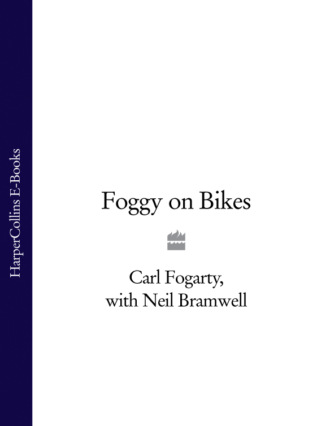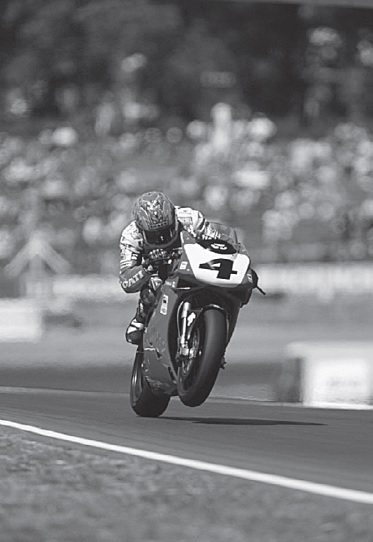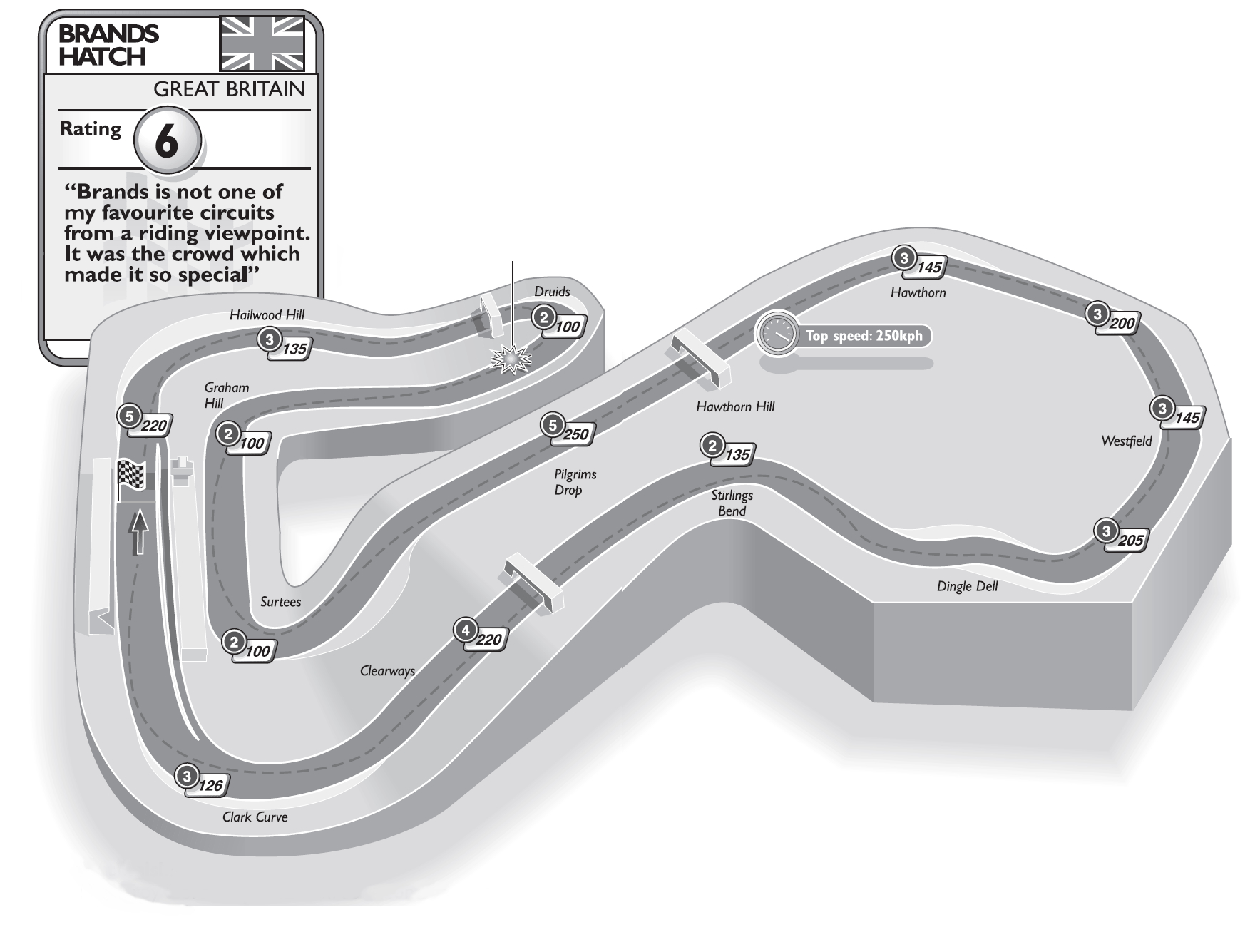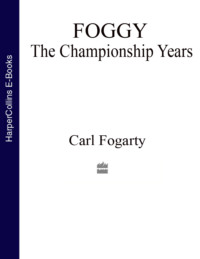
Полная версия
Foggy on Bikes
On a clear flying lap I enter the next corner, Druids, in second, while riders who don’t carry as much corner speed take it in first. That made it difficult for me to pass people on the entry to that corner, because you obviously have more chance of overtaking in first. If anyone was ever holding me up, I would use first gear to spoil their line and get past them, even if that meant I was slow around the corner. And the line of the corner was so tight that they would struggle to come back past me.
I was leading the race in 1997 when it was stopped after Graeme Ritchie was killed. After the restart I got stuck behind Neil Hodgson and John Kocinski, both of whom were holding me up at Druids. I was getting really frustrated. At one stage I tried to get on the gas too early exiting the corner and I brought the rear right round on myself so quickly that, although it didn’t high-side me, it did drop me down on a low-side. I took Simon Crafar with me when he hit my bike and Chili missed running over my hand by half an inch. I felt as low as I’d felt in my first-ever superbike race, when I was leading at Donington and crashed. I had been all set to win both races in front of a massive crowd.
You sometimes run out of road and get onto the rumble strips on the exit of the next second-gear left-hander at the bottom of Graham Hill. I try to leave the bike in third gear going along the straight behind the pits, although it will get close to the limiter for fourth gear. The next second-gear corner, Surtees, is pretty difficult because there are a few different lines. Some riders will go wide while others come up the inside, and a few bumps make it even trickier. On the exit, you’re accelerating hard up the hill to get on the back straight and it’s very hard to keep your front wheel down. You could sometimes see me, crossed up and leaning over to the right, trying to keep the front wheel down while changing to third gear.

Pulling the bike over to the right before the dog-leg, going over the rise onto the back straight at Brands, while trying to keep the front wheel down at the same time.
Before you brake for Hawthorn, you hit a dip at the bottom in fifth before the track shoots you back up the hill. There are some markers at the side of the track, numbered three, two and one, which helped me to decide when to brake and drop quickly down to third. Late in the race, when the tyres have gone off, you get a lot of movement on the exit of that corner. Then I usually stay in third gear along Westfield Bend, a fast downhill right-hander, before the track opens up to Dingle Dell in fourth.
I aim for a tree as a peel-off point for Dingle Dell Corner, and when I hit that point I look away and start to turn in because you can’t see the corner, which I take in third. It’s almost a straight line through, touching two corners on the inside and the middle one on the outside. The bike is light and nervous at that point because you’re also on the top of a brow. It’s quite spectacular.
Then I hold the bike at half revs in third gear before dropping to second for Stirlings Bend, which is a corner I don’t like. The camber of the track doesn’t seem to turn you into the corner and you have to push hard to hold the front end in. I crashed there in 1996 when I lost the front end of the Honda. It always seems to be the corner that catches you out on cold tyres, and it’s probably my least favourite corner at Brands.
When you go under the bridge before Clearways in fourth, it feels like you’re entering a stadium, with a massive crowd on the left-hand side. I like to get into the corner early, although there are a few preferred lines again, and accelerate into Clarke Curve in third. On the exit there’s a pretty bad bump which can upset the bike. On the Honda, I had to take my backside off the seat when the bike hit it because the back end of the Honda always seemed out of control. On the Ducati in 1995 I short-shifted into fourth to keep it nice and smooth through the bump and stop it wallowing down the straight. Then it’s through the start–finish straight, which typifies Brands because it’s not really a flat straight as it slopes down towards the pit-lane.

Worst Crash: The restart of the second race in 1997. I hit the gas too early exiting Druids and robbed myself of a double win. Best Moment: When I won both races on a red-hot day in 1995, virtually clinching the world championship. Closest Finish: In 1998, Troy Corser opened a three-second gap but I had to hold off Jamie Whitham and the two Hondas for second place. Best Other Rider: Giancarlo Falappa won both races in 1993 by a mile in the worst rain I’ve ever seen. Worst Moment: I’ve been either hit or mis at Brands but the tyre problems I had in 1999, in front of 120,000 fans, was the lowest point.
Section 2 Racing Techniques
‘Carl Fogarty the person and Carl Fogarty the rider are two different people, but his personality has a lot of influence on his riding. Sometimes, he had to be aggressive off the track because it was the only way he knew how to transmit his personality. When he is with other people he sometimes looks uncomfortable if he doesn’t know them. Carl is still a bit shy, even after all his success.
‘In the beginning he was a bit hard to manage because I had first to try to understand him. Then I was lucky because we found a very good feeling together. It’s not so difficult to read him. It means looking him in the eyes and already knowing what he needs and what he wants, or what he wants to say. Also, he understood that I was often already doing what he was going to ask for.
‘Carl was very aggressive on the throttle, so we needed to set the bike up hard on the rear. Especially when he thought the grip was poor, he would turn the throttle so quickly that it was difficult to set the rear suspension. But, at the end of the day, you could always say that Carl would ride round any problems with the bike. He would try hard during qualifying but we always knew that he would put in 110 per cent on race day.
‘His body used to move a lot on the bike and he would use his weight to adapt to different corners. And if there were problems with the bike, he would use his own body to solve them by hanging off at different angles. He would not hang off as much as someone like James Whitham, but just use his bodyweight to hold the corners. In that way he could carry high corner speed, a big part of his technique.’
Davide Tardozzi
Ducati factory team manager
Конец ознакомительного фрагмента.
Текст предоставлен ООО «ЛитРес».
Прочитайте эту книгу целиком, купив полную легальную версию на ЛитРес.
Безопасно оплатить книгу можно банковской картой Visa, MasterCard, Maestro, со счета мобильного телефона, с платежного терминала, в салоне МТС или Связной, через PayPal, WebMoney, Яндекс.Деньги, QIWI Кошелек, бонусными картами или другим удобным Вам способом.




